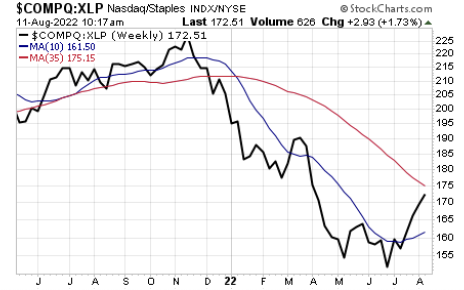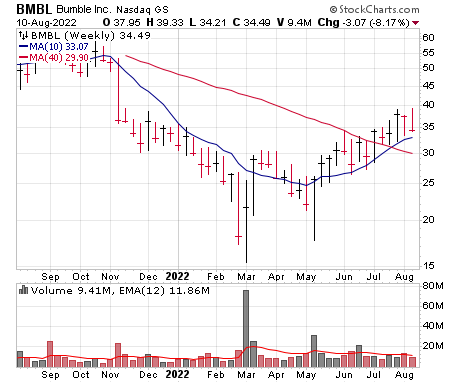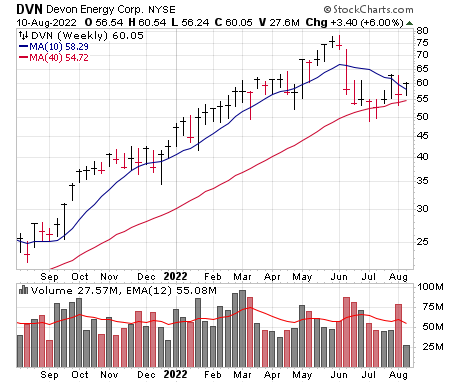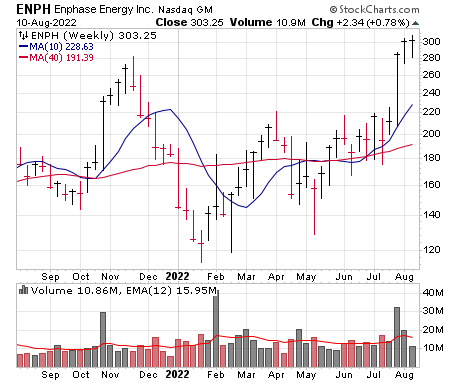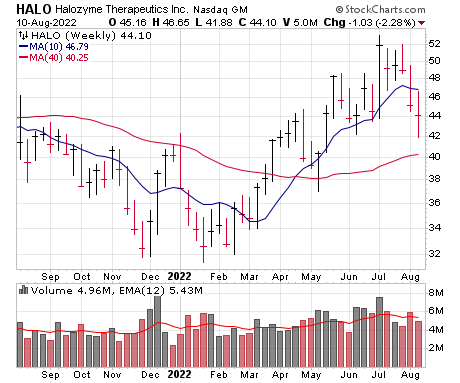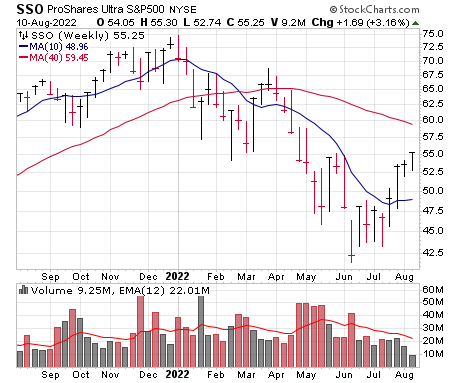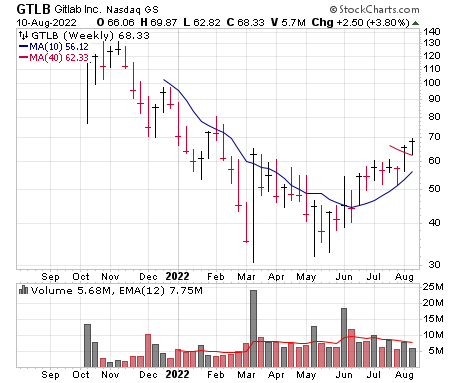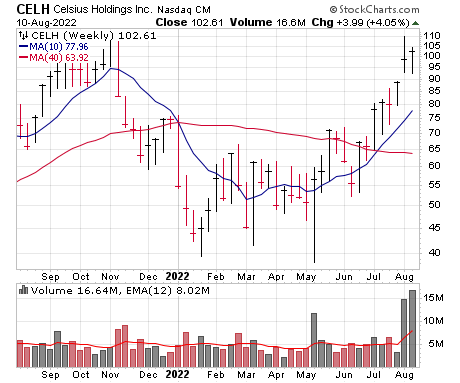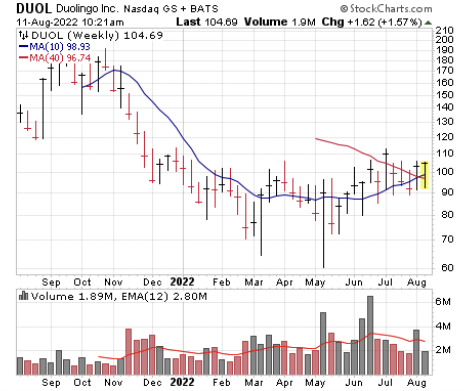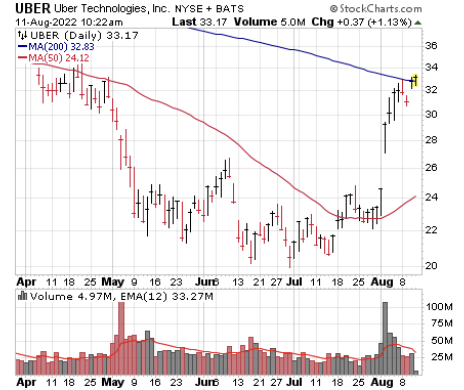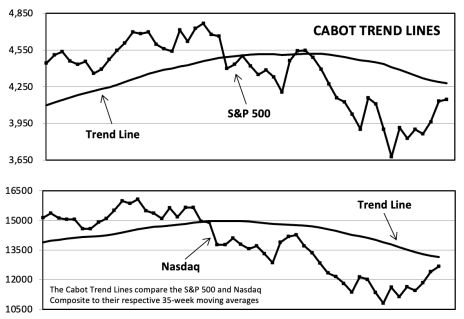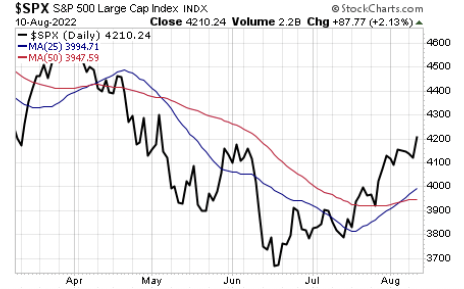The market’s evidence continues to slowly, steadily improve--it’s not 1999 out there, but there also aren’t any obvious yellow or red flags, either. Given the trickiness of individual stocks, we’re still thinking going slow makes sense, but we’re aiming to extend our line as stocks present opportunities, while punting on names that are breaking down. In the Model Portfolio tonight, we have some changes, but on balance we’re pushing more toward the bullish position.
We also talk about playing so-called off-the-bottom stocks (and have one old friend we’re keeping an eye on from that group), as well as reviewing some names we’re watching and presenting one sign that says most investors are still worried about the market (usually a good sign).
Cabot Growth Investor Issue: August 11, 2022
No Predictions Please
The market is driven by investor psychology as much as if not more than fundamentals, and one thing that becomes obvious if you pay attention is how that psychology changes depending on prices—clearly, if the market is up people get more optimistic, while a bear phase brings a lot of worry and pessimism. But more than that, we’ve noticed that the more volatile the market, the more dramatic everyone’s viewpoints. (Part of that is because big, dramatic outlooks and predictions get clicks and viewers—but that’s a discussion for another day.)
Right now, for instance, most pundits either see a new bull market having been born, with much higher prices down the road as the Fed eases off the brake and lower valuations and interest rates bring in the buyers—or that this is just a bear market rally, soon to run into tons of overhead and lead to another sharp leg down that destroys another truckload of wealth.
But while it can be fun to debate and guess, you’re always better off just sticking with what you see—and today, what we see is something of a middle ground. Clearly, this isn’t a hands-down, runaway, 1999-type bull market, as the market still has hurdles to over come (few stocks are hitting new highs; longer-term trend is still down). But we’re also not seeing any developing red (or even yellow) flags, either, with the evidence showing a steady improvement during the past month—including for individual stocks, with more quality names acting peppy compared to just a couple of weeks ago. Hence, we’re extending our line, but doing so in a slow, measured fashion.
Probably the biggest thing we’re on the lookout for in the days and weeks ahead is (as we call it) a hyper-overbought condition—something that’s almost always a good thing, with a signal confirming the bottom is in and a new bull has begun. We’re seeing a few minor things of late; yesterday’s NYSE up volume ratio was north of 12-to-1, the largest since 2020. And, more important to us, on the breadth front, about 80% of NYSE stocks are above their 50-day lines; if that gets to 90%, it would trigger the 90% Blastoff Indicator, which would be a very strong sign the market will be working its way higher for many months to come.
What to Do Now
But, as we just wrote above, we’re not predicting anything. Instead, we’re going with what we see, which is increasingly encouraging but not pound-the-table, per se. In the Model Portfolio, we’re tip-toeing further into the water tonight, averaging up on Shockwave Medical (SWAV) and Enphase Energy (ENPH), though we also have two stocks on relatively tight leashes that could be jettisoned if they don’t hold up. Our cash position will be around 60% after these buys.
Model Portfolio Update
We all prefer environments where the market bottoms and immediately turns around, with growth stocks racing to the moon within a few days; in fact, the last two bear phases (Q4 of 2018 and the pandemic crash) brought about this kind of action. This go-round, though, was bound to be different given the damage done to so many growth titles, with most potential new leaders facing lots of overhead and being somewhat thinly traded.
And that’s what we’ve seen during the past few weeks—the top-down evidence has been encouraging, with our Cabot Tides green light working well and some important signposts we watch (like our Aggression Index, shown below) turning positive (the 10-week line has turned up). That said, individual stocks have been good but tricky, with plenty of potholes, rotation and news-driven moves, too. While the sellers seem to have mostly left the building, buyers remain a bit hesitant, with big investors likely dipping toes into the water instead of cannonballing from the top diving board.
So we’re doing the same thing—our crop of stocks are doing mostly well, though we’ve seen a couple of body blows this week on earnings (HALO and BMBL); we are holding but using tight stops on both. Though tonight we’re also going to play some offense, averaging up in Shockwave after a huge earnings report and doing the same in Enphase even though we bought that relatively recently. That will leave us with around 60% in cash (a bit less), which we’ll aim to continue deploying if the market and (most importantly) leading stocks shape up.
Current Recommendations
| Stock | No. of Shares | Portfolio Weightings | Price Bought | Date Bought | Price on 8/11/22 | Profit | Rating |
| Bumble (BMBL) | 2,769 | 5% | 35 | 7/22/20 | 32 | -9% | Hold |
| Devon Energy (DVN) | 2,413 | 8% | 28 | 6/4/21 | 64 | 129% | Hold |
| Enphase Energy (ENPH) | 340 | 5% | 286 | 8/3/22 | 295 | 3% | Buy a Half |
| Halozyme (HALO) | 1,887 | 4% | 52 | 7/7/22 | 43 | -16% | Hold |
| ProShares Ultra S&P 500 (SSO) | 1,705 | 5% | 47 | 5/29/20 | 55 | 17% | Hold |
| Shockwave Medical (SWAV) | 457 | 7% | 213 | 7/22/20 | 281 | 3% | Buy a Half |
| CASH | $1,357,487 | 67% |
Bumble (BMBL)—Bumble reported earnings last night, and simply put, they weren’t great, with sales up 18% and earnings in the red, though interestingly it’s really a tale of two operations: The firm’s international arm (Badoo) is doing poorly, with users down 25% from a year ago and revenue off 14%, while Bumble (U.S.-based) looks just fine, with users rising 31% and revenue up a bit more than that. Still, the top brass did lower the forecast due to Badoo (and currency headwinds), and after trying to find support early today, the stock finished sharply lower, closing below its 50-day line for the first time in three months. Is BMBL toast? It could be, maybe the international drag will just be too much to handle. That said, we’re not quite ready to bury the stock at this point, with the underlying growth of the core business looking good and with the stock back in an area of support. We’ll switch to a Hold rating and will be using a tight leash (another point or so) from here. HOLD
Devon Energy (DVN)—Devon Energy is sticking to the new playbook in the energy sector, with limited CapEx and production growth as it harvests cash flow. Interestingly, though, while it’s prioritizing payouts ($1.55 per share will be sent at the end of September) and share buybacks, it’s also using that cash flow to engage in some modest-sized acquisitions: Last month the firm completed a bolt-on acquisition (bolt-on = adding acreage and wells near or right adjacent to areas it already owns) in the Williston Basin for $865 million, and now it’s going bigger (though not huge), announcing this week a $1.8 billion, all-cash, bolt-on purchase in the Eagle Ford (Texas) that brings with it 42,000 areas, 350 new drilling sites and 150 “refract” drilling sites. Moreover, it appears to come at a solid purchase price (30% free cash flow yield at today’s prices!) that management said will boost Devon’s overall free cash flow metrics by about 10% given stable energy prices. Speaking of prices, we’re intrigued by the fact that, while near-term oil prices have pulled in, (a) they remain north of $90, and prices looking out a bit (we’ve been keeping an eye on the December 2023 contract) have been more stable, still hovering in the low $80s as they have for the past month; anything around there would result in big dividends and share buybacks for a long time to come. Thus, the fundamentals remain in place for higher prices, now it’s up to the stock to oblige—and it’s starting to do so, as DVN has tested and held its 200-day line twice and surged above its 50-day line today. If it can hold or build on this move, the correction is probably over, but we’ll stay on Hold a bit longer to see if sellers have really lost control. HOLD
Enphase Energy (ENPH)—ENPH has been quieting down, meeting with a little round number resistance (at 300) as it digests its massive breakout-and-rally action from late July. It’s looking like nearly a sure thing that the green energy bill will be passed through Congress and signed into law, with a 10-year solar tax credit likely to clear the way for further investment and longer-term planning in the sector. Of course, Enphase’s story is much larger than just this bill—demand for its microinverters and (increasingly) storage solutions are going gangbusters, with U.S. growth excellent and demand from Europe going through the roof as people and companies look for some energy surety. Back to the stock, a bit more digestion would probably be a good thing, and we’re not ruling out a shakeout given the stock’s big run if the market hits a pothole—even so, ENPH is positioned as one of the potential liquid leaders of this move, so if the market rally persists, it should do well. Said another way, there’s risk if the market rally falters, but the upside should be much larger if things go well. Throw in the fact that we still have plenty of cash on the sideline, and we’re going to go ahead and fill out our position in ENPH, buying another half here. We’ll be using a loose loss limit in the 230 area (give or take), which is near the 10-week line to give the stock room to maneuver. BUY ANOTHER HALF
Halozyme (HALO)—Fundamentally, nothing seems amiss with Halozyme—in fact, business is good and getting better, with Q2 results coming in slightly better than expected (sales up 12%, royalty revenue up a huge 86%, earnings of 53 cents coming in six cents ahead of estimates), and with the top brass raising its guidance a bit, mainly due to the closing of its buyout of Antares Pharma; earnings should hit $2.10 per share or so this year, and then kite higher 30%-plus in 2023. Despite that (and some sanguine views from analysts), the stock came under lots of pressure in the two weeks before the report, and after a brief gap up, HALO gave up its gains yesterday … though so far, it’s held above our mental stop in the 42 to 43 area. One reason for the weakness could be nervousness about potential pricing issues stemming from the inflation/green energy bill going through Congress; management was non-committal given that it will take a while for regulations to be written, but it’s possible some investors aren’t taking chances. As usual, we’ll play it by the book—if HALO can hold up here-ish, we’ll hold on, as the royalty and earnings stories looks just fine. But should the stock be unable to find support here, we’ll throw our half-sized stake overboard and look for greener pastures. Hold for now. HOLD
ProShares Ultra S&P 500 Fund (SSO)—ProShares Ultra S&P Fund continues to act well, setting new recovery highs this week as the major indexes push higher and some secondary factors (like our Aggression Index, mentioned above) offer encouragement. In the near term, we’ll be very interested to see if the strength continues, because if it does, we could get a mini-blastoff signal: About 86% of S&P 500 stocks are north of their 50-day lines, and getting into the 90% to 92% area has historically correlated with higher prices down the road. (Note that our 90% Blastoff Indicator, which is more reliable, applies to the entire NYSE; that potential signal is a bit further off given the current reading is 80%, but getting north of 90% on the S&P would certainly be a bullish sign in and of itself.) Of course, we’re also not leaving our brain at the door here—our long-term Cabot Trend Lines are still bearish, and even after this upmove, the S&P is “only” back up to its lows from February/March. Should we see further positive evidence (especially a blastoff signal), we’ll not only go back to Buy but likely add a chunk of new shares in SSO—for now, though, we’re content to simply sit with our remaining position in this leveraged long fund and take it a day at a time. HOLD
Shockwave Medical (SWAV)—Shockwave Medical reported another fantastic quarter this week, crushing estimates and kicking the outlook much higher for this year and down the road. In Q3, sales again more than doubled (up 116%) while earnings of 68 cents per share were up from a loss a year ago and topped by 24 cents, with both coronary and peripheral business lines easily topping Wall Street’s estimates. The new round of analyst forecasts aren’t totally in yet, but Wall Street at this stage is looking for earnings of around $2.50 per share this year (up from $2-ish pre-report) and a 38% gain in 2023, but both of those figures are likely to prove conservative as many catalysts (Japan launch early next year, which should start slow but become a giant area for its coronary products in the long term; a ramp up in its China joint venture and new products should also goose growth down the road) come into play. SWAV had nosed above resistance in the 220 area before the report, and the action since then has been excellent, with a big gap up on Tuesday and some upside follow-through on Wednesday and today driving the stock to new price and relative performance peaks. Short term, we do think SWAV could pull in, so if you want to just hold what you have (or aim to nibble on dips), there’s nothing wrong with that. However, we’re focused on the larger picture, where Shockwave’s top-notch growth profile and chart action (resilience during the bear phase, moving to new highs soon after a market low) could lead to something meaningful if the market holds together. Thus, we’ll fill out our position here, using a stop for the combined position in the 205-210 zone. BUY ANOTHER HALF
Watch List
- Celsius (CELH 103): CELH is the top name on our watch list right now, with superb numbers, a true mass market story and a recent deal with Pepsi that should keep business growing rapidly for a very long time to come. See more later in this issue.
- CrowdStrike (CRWD 198): CRWD doesn’t have the perfect chart, but it continues to show relative strength and has a story and set of numbers that’s hard to match. We think it can be a magnet for institutional money if growth stocks truly kick into gear.
- Duolingo (DUOL 104): DUOL had a very solid Q2, though the stock remains choppy around the century mark. A big breakout could kick off a sustained advance.
- Gitlab (GTLB 69): GTLB is setting itself up as something of a bullet supplier to the software wars, with the platform of choice to help mid- and large-sized companies quickly and efficiently build their own software products for customers and employees. See more below.
- Pure Storage (PSTG 30): PSTG is still gliding higher, enjoying a persistent advance since early July as the sellers appear worn out. The chart still needs some work, but we think the next major move should be up.
- Uber (UBER 32): We write about UBER later in this issue—it’s not quite set up yet, but the still-solid growth figures and the raw power off the low on earnings has us keeping an eye on it. Not that it’s going to be
Other Stocks of Interest
GitLab (GTLB 69)—GitLab is a small company that smells like it’s going to be a lot bigger in the years ahead—something that has an emerging blue-chip feel to it. The attraction here is that, as more and more of the world is being run by software—basically every mid- to large-sized company has their own group that’s producing consumer- and employee-facing software—GitLab’s has positioned itself as the top platform helping these development and operations teams quickly and efficiently produce new offerings. It’s a huge and growing market: The top brass sees a $40 billion opportunity as big firms move from narrow and do-it-yourself solutions (juggling tons of different tools and integrations—GitLab calls this the digital duct tape problem) to all-in-one platforms, and GitLab thinks it’s the only platform that brings together all the aspects of the two teams (plan, create, verify, secure, release, etc.) in one place, with one interface, one set of reports and one place for everyone to contribute. Firms from a wide variety of industries are customers (Siemens, UBS, T-Mobile, Equinix, Ticketmaster, Iron Mountain, Nvidia, Vistaprint, etc.); it ended May with 5,168 clients that produce at least some revenue, up a whopping 64% from a year ago, while growth in big customers (those that produce six-figures in revenue for GitLab) was even faster, up 68%—and all of them are buying a ton more of GitLab’s offerings, with same-customer revenue growth regularly north of 30%! The combination has produced accelerating top-line growth (up 58%, 69% and 75% the past three quarters), and while that may slow some, 35% to 60% growth is likely for a long time to come. The bottom line is still in the red, but losses are steadily shrinking and the focus here is on the opportunity ahead. As for the stock, GTLB bottomed back in March with out-of-this-world volume support after earnings, with the retest in May holding—and shares have actually been trending higher since then, holding north of its 50-day line for about a month and a half. Like most everything, the chart still has barriers to overcome, but the story, numbers and (increasingly the) chart suggest this could be a new leader. GitLab is on our watch list.
Celsius (CELH 103)—We’ve been keeping our eye on CELH for a couple of months now, which, frankly, has been a mistake—we should have nibbled on it, as shares have done pretty well. Even so, we think there could be plenty more upside ahead, with any weakness potentially setting up a good entry point going ahead. To recap, the company looks like the next big winner in the energy drink market (first was Red Bull, then Monster, now Celsius), and that’s because it offers something different, with independent studies showing its unique formula actually boosting metabolism, and it doesn’t hurt that the drinks are healthy otherwise, too (no preservatives, aspartame, added sodium, etc.). Celsius has just 4%-ish of the market, a figure that’s growing quickly thanks to major distribution expansions (Sam’s Club, Walmart, Lifetime Fitness). And now something even bigger has happened—behemoth Pepsi has struck a long-term distribution deal with the company, which will obviously open up tons more shelf space (both in existing locations and new doors), and Pepsi also took an effective 8.5% stake in CELH (via a $550 million purchase of convertible preferred stock). Growth was already fantastic (sales up 137% and earnings of 12 cents per share in the just-reported Q2), and while it will take some time to ramp up, there’s little doubt the Pepsi deal is going to supercharge results going forward. The stock lifted above some resistance in early July, pushed higher for a few weeks and then gapped toward its old highs on the Pepsi news; it’s since chopped around, with some selling after the good news but then support after earnings. After a big run from its lows and with the market environment still so-so, the recent rest period could certainly go on for a bit, allowing the moving averages to catch up. But bigger picture, the stock’s deep correction, multi-month low area and recent strength—as well as the sterling fundamental prospects—make us think CELH best days are ahead of it. Our eyes are peeled for an entry point.
TransDigm (TDG 658)—Most investors don’t think of aerospace names when they think of growth stocks, and to some extent that makes sense, as the industry does have some dry times. But the fact is that (a) when an upcycle gets going in this group, it usually lasts for many years, and (b) there aren’t many players in the sector, so a handful of outfits get most of the increased business. TransDigm is a name we’ve kept a distant eye on for years, as it has an enviable position in the aerospace world: The firm makes highly-engineered components like pumps, values, motors, actuators, couplings, batteries, cockpit security systems and much, much more, but the big attraction is that most of these products aren’t run of the mill—in fact, something near 90% of its offerings are proprietary and TransDigm is the sole-source provider for many of them, which keeps demand and margins elevated (after-tax profit margins came in at 20% in Q3). And there’s also a huge aftermarket business, at least on the commercial side of things (the overall business is split nearly evenly between defense and non-defense today, though as the pandemic eases commercial revenue should be about two-thirds of the total), which smooths out most peaks and valleys when it comes to larger orders. The firm saw a slow time with the industry in 2019 and especially 2020 (commercial demand fell with Covid), but now business is roaring back, with strong sales and (especially) earnings growth during the past five quarters (the just-reported Q3 saw sales up 15% and earnings up 46%), and with analysts seeing the bottom line rising north of 35% this year and again in 2023. (The firm also declared a special $18.50 per share dividend; ex-dividend is August 19.) Bigger picture, TransDigm might be the best way to play the new travel boom as the pandemic continues to dissipate and everyone shakes off their cabin fever. To be fair, the stock is high-priced ($600 names aren’t our usual fare), but TDG has built a huge launching pad during the past year and a half, and the shakeout with the market in June likely cleared the air, with shares pushing right back to their prior highs in recent weeks. It’s not going to be your fastest horse, but TransDigm has a rapid, reliable growth story for at least the next couple of years that should keep big investors buying if the market behaves itself.
Playing “Off the Bottom” Situations (Know What You’re Dealing With)
The rally since mid-July has been solid, but as we’ve written, the vast majority of action has been from what we loosely call off-the-bottom names—stocks that were destroyed 60% to 80% during the past few months and are now bouncing off the bottom. After all, if a stock falls from a price of 100 down to, say, 30, then rallies back to 45, it’s enjoyed a big 50% move off its low … even though it’s still 55% below its prior peak.
As it turns out, throughout history two things are common in bear markets, and in the periods when a bear is transitioning to a bull: (a) many of the bear’s worst performers will bounce the most percentage-wise, but (b) very few (if any) of those will go on to enjoy real sustained advances. Does that mean you should never play these types of stocks? No, you absolutely can—just be aware that they’re most likely trading situations (holding for three or four weeks assuming all goes well) and not things you’ll be able to hold onto for many months. If you’re OK with that (and with giving the stocks a lot of room to maneuver since they’re so volatile), there’s nothing wrong with taking a stab at a couple of them.
Our system is built more around position trading, which is another way of saying we’re aiming to hold for the intermediate- to longer-term, assuming the stock performs well. That said, we’re also flexible—while we’d love to be buying breakouts of new leaders to all-time highs, there aren’t going to be many of those right now given the damage done during the bear phase. So the trick is finding stocks that have been beaten down … but are also capable of being fresh leaders and having big sustained runs if the market does.
For that, we advise looking for two things. The first is simply a multi-month bottoming area; we’ve been highlighting many of these in “Other Stocks of Interest” during the past few issues, such as Braze (BRZE) and Duolingo (DUOL), with Gitlab (GTLB) in today’s issue another example. By showing relative strength for months (holding up while the market tanked) and now perking up, all have a solid foundation to run—if they can decisively get going.
The second thing to look for is possibly a briefer bottoming effort, but clear, massive upside volume for a few days from a big, liquid name that still has solid numbers. One old friend we’re keeping an eye on in that vein is Uber (UBER), which was clobbered in recent months on economic fears, not to mention a big valuation and never-ending red ink. But, interestingly, business is actually healthy here—while delivery (think Uber Eats and more) bookings were up just 12% in Q2 (currency neutral dollars), rides were up 57% as the pandemic faded.
And more important, the top brass is now focused on cash flow—Q2 saw EBITDA leap into the black while free cash flow was around 20 cents per share, and management sees EBITDA (a broader measure of cash flow) surging further in Q3. The stock’s “bottoming phase” lasted just a couple of months, but the post-earnings rally caught our attention, with five straight big days of buying and the second largest weekly volume since the pandemic crash. There’s still plenty of overhead here (including from the 200-day line), but we’re keeping an eye on UBER—it looks like the worst is over and a few weeks of calm action could set up a so-called turnaround entry point. WATCH
The Man on the Street is Selling—and that’s a Good Thing
It didn’t take but a couple of months of this bear phase before many sentiment-related measures began to show some pessimism among investors; in particular, surveys (like AAII or Investor’s Intelligence) quickly showed investors were thinking worse times were on the way, and some ancillary measures (like the put-call ratio) ratcheted up after the Russian invasion, too.
But the measures that involve money flows, specifically into and out of equity mutual funds and ETFs, didn’t do the same: Despite the war, Fed tightening, the growth stock meltdown and more, the man on the street was still happily shoveling money into the market. But finally, the market’s April/May implosion brought some selling, and after a brief period of hope, the average Joe and Jane are clicking the sell button with recession on everyone’s mind.
Our Real Money Index, which we still track every week (it’s the five-week sum of money flows into all equity funds) showed this action. It’s even better seen when you broaden it out to an eight-week sum: You can see the rush out of the market in April/May, then a quick bounce back but now a sag deep into negative territory, with the reading recently testing its lows (most outflows) from the summer of the pandemic.
Obviously, we’re cluing off more primary indicators right now when it comes to adding exposure, but this situation is relatively classic—many investors make decisions based on today’s news, which is still horrible (and will likely get worse), but the market looks ahead six to nine months and (so far) is liking what it sees. The longer these money flows persist, the better it is for the market from a contrarian point of view.
Cabot Market Timing Indicators
We’ve seen a steady improvement in the evidence during the past month, with our Tides turning positive, our Aggression Index (see earlier in this issue) doing the same and other very key measures (Trend Lines, Two-Second) approaching positive territory. Individual stocks are still tricky, but there’s improvement there, too—we’re going slow but still aiming to extend our line.
Cabot Trend Lines: Bearish
Our Cabot Trend Lines continue to improve, but there are still a few more hurdles to overcome before the long-term trend turns up—at this point, both the S&P 500 and Nasdaq are just 1% to 2% below their respective 35-week moving averages, a huge improvement from a month ago, though for a buy signal, we need to see both indexes close two straight weeks above their trend lines. Thus, there’s still work to do, but we’re watching closely.
Cabot Tides: Bullish
Our Cabot Tides remain on a green light, with the market acting well since the buy signal in the middle of July—all of the major indexes we track (including the S&P 500, daily chart shown here) are kiting higher above both their 25-day and 50-day moving averages. Moreover, there’s plenty of “daylight” between the indexes and their lower (now 50-day) moving averages, giving them plenty of leeway to wiggle around without damaging the intermediate-term uptrend.
Cabot Two-Second Indicator: Neutral
Our Two-Second Indicator has definitely improved with most everything else of late—including today, we’ve seen sub-40 readings for six the past eight days. That said, we still need to see a few of these readings in a row to conclude the sellers have left the building; right now, we’ll rate the indicator neutral, but what happens from here (a continued dry-up in readings vs. an expansion on any market pullback) should be very telling.
The next Cabot Growth Investor issue will be published on August 25, 2022.
About the Analyst
Mike Cintolo
A growth stock and market timing expert, Michael Cintolo is Chief Analyst of Cabot Growth Investor and Cabot Top Ten Trader. Since joining Cabot in 1999, Mike has uncovered exceptional growth stocks and helped to create new tools and rules for buying and selling stocks. Perhaps most notable is his development of the proprietary trend-following market timing system, Cabot Tides, which has helped Cabot place among the top handful of market-timing newsletters numerous times.

